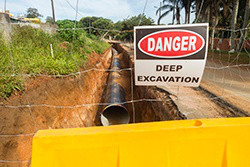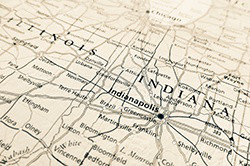 The walls will fail; we just don’t know when they will fail. A rule to always remember about trenching.
The walls will fail; we just don’t know when they will fail. A rule to always remember about trenching.
Consider this scenario that led to a worker’s death:
A false sense of security was formed because the workers had been doing similar work for 20 years without a serious accident or death. They knew they were out of compliance with the trenching and shoring standard, but they probably planned to be in the trench for only a few hours and thought everything would be okay. They thought the soil was stable, possibly because the trench was dug over 2 weeks ago and nothing had happened. Plus, other workers were in the trench just yesterday and nothing happened to them. But it rained overnight. The conditions that seemed to create stable soil had changed. The soil became wet. The trench collapsed. They could not save their co-worker and he died.
By following OSHA’s excavation standards you can help prevent tragedies like this one and promote workplace safety.
What is the greatest risk in trenching and excavation? Cave-ins.
This is when soil or rock suddenly falls or slides into an excavation. It becomes dangerous when it includes a sufficient quantity of soil or rock to entrap, bury, injure, or otherwise immobilize a person. Soil weighs approximately 125 lbs. per cubic foot. When wet, it can weigh as much as 145 lbs. per cubic foot. A worker in a trench can be crushed by soil, rock, or an object during a cave-in. There is also a significant risk of suffocation – even if the worker’s head is not buried, the soil can prevent chest expansion.
Additional hazards associated with excavation include hazardous atmospheres, falling soil or equipment, water accumulation, electrical hazards, and more.
These risks are recognizable and preventable. You can take action to prevent excavation and trenching tragedies at your workplace. Help open workers’ eyes about trenching hazards, safe work procedures, and a potentially dangerous thought process.
Numbers To Remember
There are numerous aspects of OSHA’s excavation and trenching standards you should review in your workplace, but we’d like to review several of the elements that can be remembered with the following 9 numbers:
- Keep spoil pile 2 feet from the edge of the trench.
- Ladders should be secured and extend a minimum of 3 feet above the landing.
- Trenches 4 feet or more in depth need proper access and egress.
- If a competent person suspects a hazardous atmosphere, testing will begin at 4 feet or less.
- Each employee in an excavation must be protected from cave-ins when the excavation is deeper than 5 feet or the competent person determines protection is necessary.
- Support systems should extend 18 inches above the excavation.
- At 20 feet or deeper, a professional registered engineer will design the protective system.
- Excavations of earth material should not be to a level not greater than 24 inches below the bottom of the shield.
- Spacing between ladders or other means of access/egress should not be more than 25 feet laterally.
For complete details on the OSHA standards relating to excavating and trenching, visit the OSHA website.
Help prevent cave-ins and other excavation tragedies by educating employees on the dangers and safety procedures.



